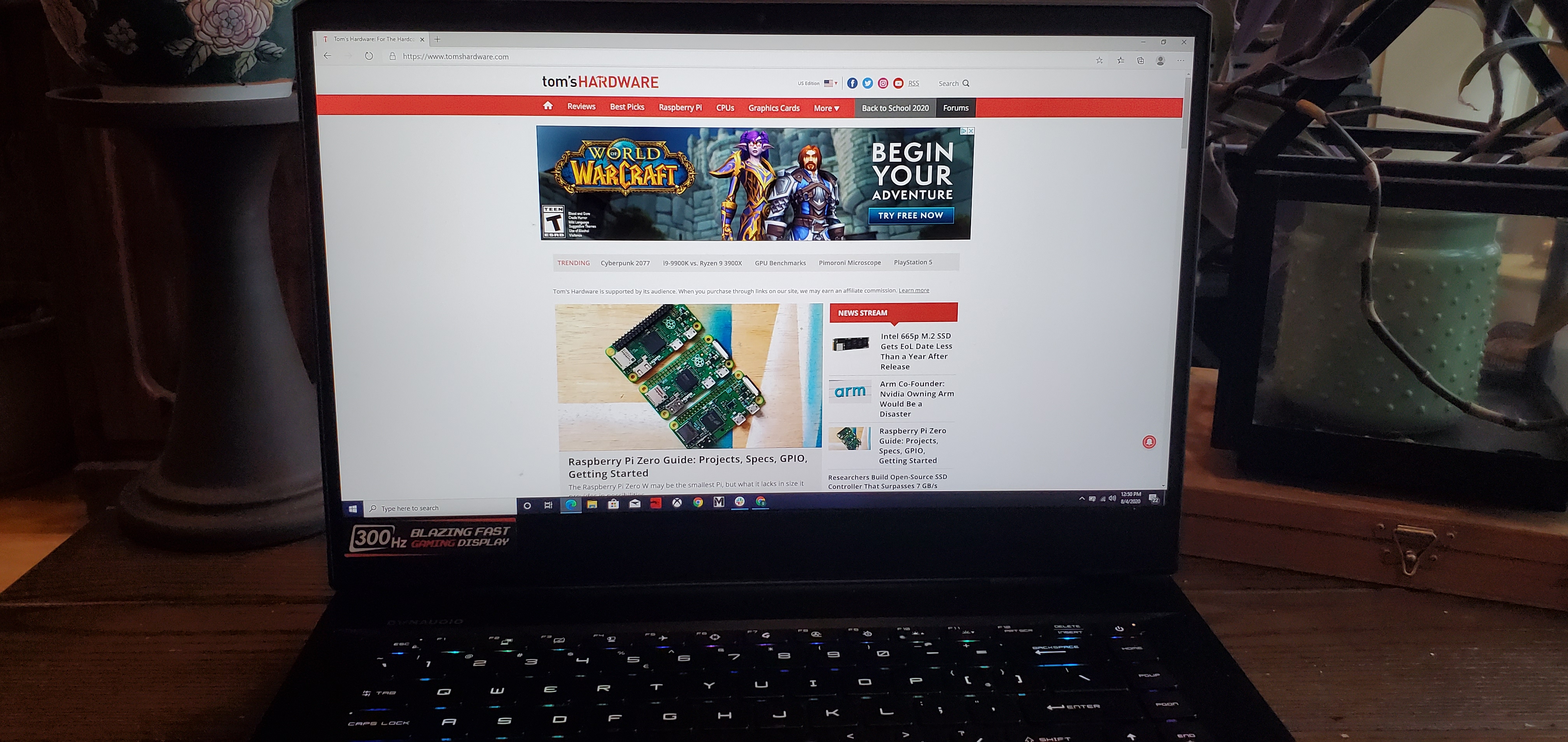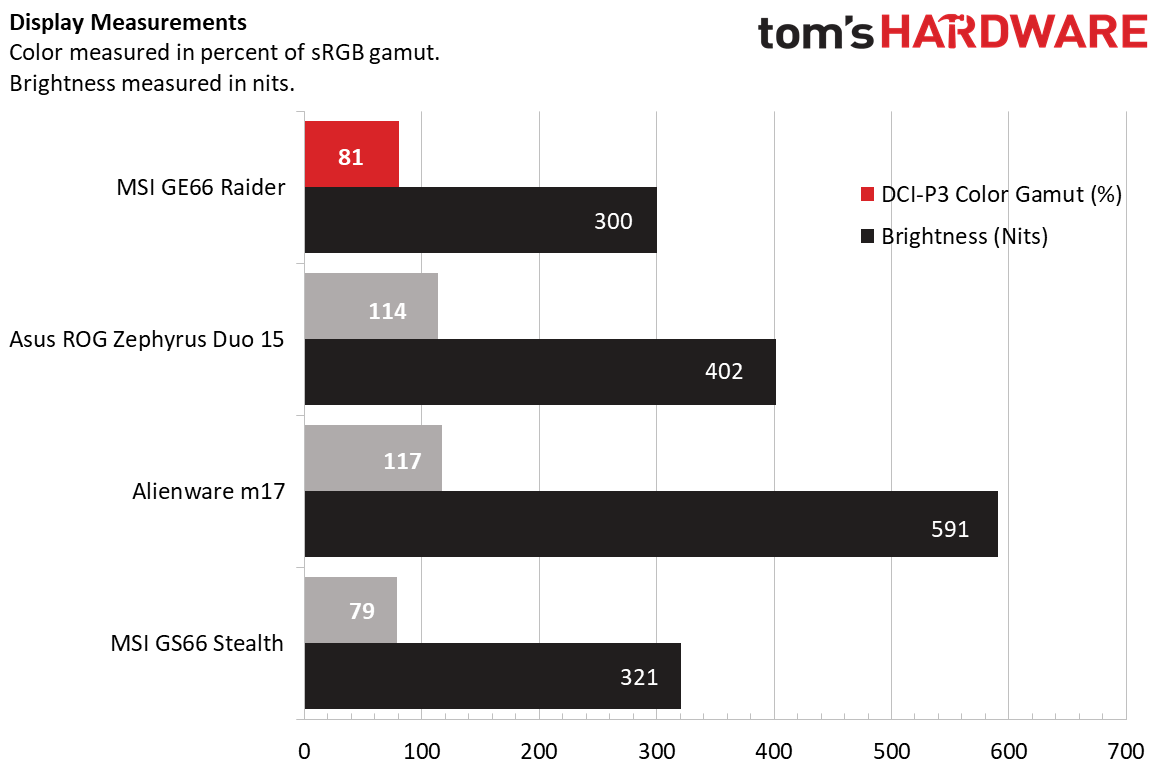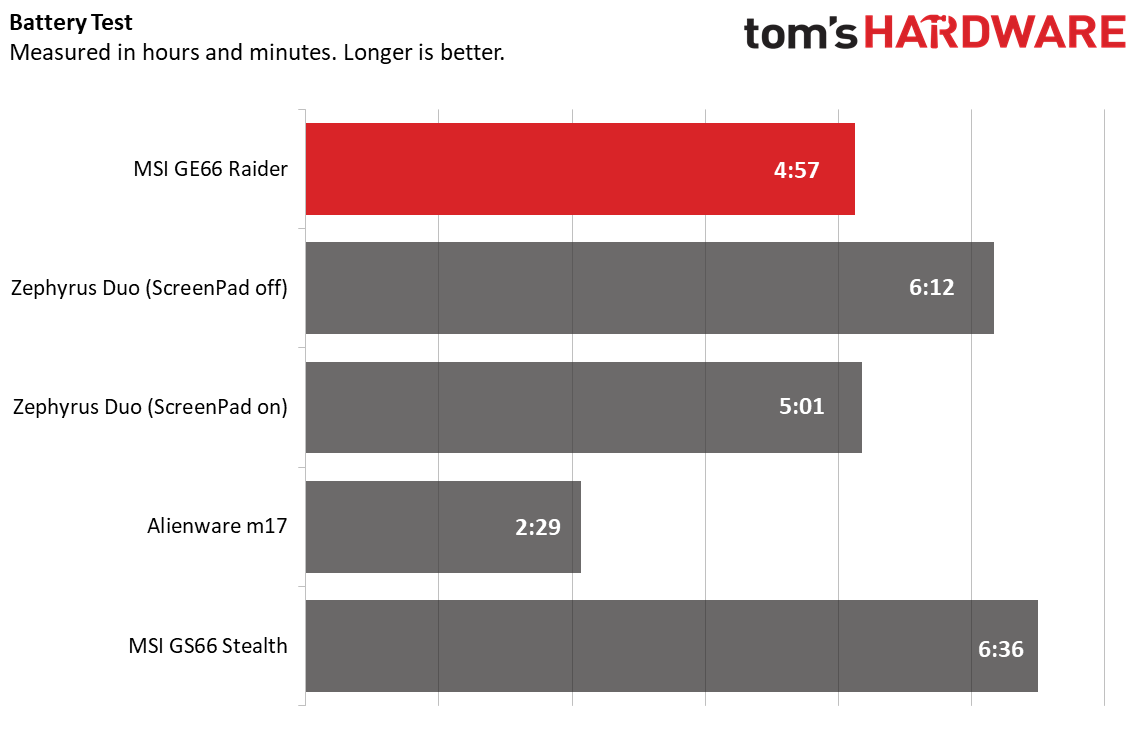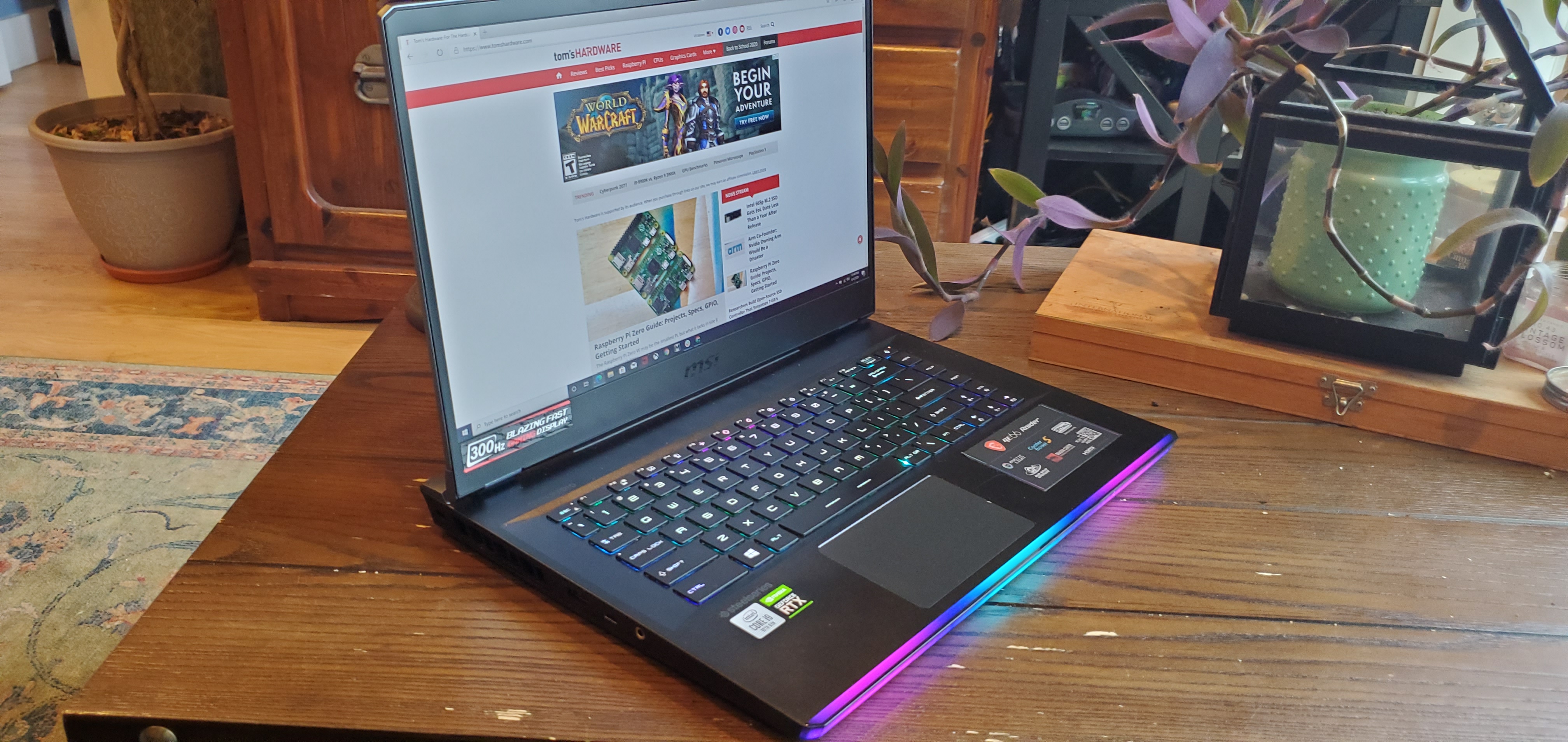Tom's Hardware Verdict
The MSI GE66 Raider sits atop a beautiful RGB bar, and that’s just the start of its premium build. Gaming framerates are competitive or better than slightly pricer rivals, and the 300 Hz screen is great for esports.
Pros
- +
Great gaming performance
- +
300 Hz display
- +
Well-executed RGB light bar
- +
High-end build
Cons
- -
Cramped keyboard
- -
Tinny audio
Why you can trust Tom's Hardware
If you’ve ever wondered, “Why aren’t gaming laptops flashier?” the MSI GE66 Raider is for you. With an RGB light bar and keyboard, aluminum build and trim design, it’s as beautiful as its price suggests -- $1,899 to start, $2,999 as tested.
Packing an RTX 2080 Super Max-Q graphics card and 10th Gen Intel Core i9 CPU, The GE66 Raider proved it’s ready to make ample use of its mind-blowing 300 Hz display, too.
MSI GE66 Raider Specs
| CPU | Intel Core i9-10980HK |
|---|---|
| Graphics | Nvidia GeForce RTX 2080 Super Max-Q (8GB GDDR6) |
| RAM | 32GB DDR4-3200 |
| Storage | 1TB PCIe NVMe SSD |
| Display | 15.6 inches, 1920 x 1080 resolution @ 300 Hz, 3ms |
| Networking | Killer Ethernet E3100 LAN, Killer Wi-Fi 6 AX1650 (2*2ax), Bluetooth 5.1 |
| Ports | 2x USB 3.2 Gen 1 Type-A, USB 3.2 Gen 2 Type-A, USB 3.2 Gen 2x2 Type-C USB 3.2 Gen 2 Type-C (DisplayPort 1.4), HDMI 2.0, Mini DisplayPort 1.4, SD card reader, 3.5mm headphone/mic jack |
| Camera | 1080p |
| Battery | 99WHr |
| Power Adapter | 280W |
| Operating System | Windows 10 Home |
| Dimensions(WxDxH) | 14.1 x 10.5 x 0.9 inches (358.1 x 266.7 x 22.9mm) |
| Weight | 5.3 pounds (2.4kg) |
| Price (as configured) | $2,999 |
Design of MSI GE66 Raider
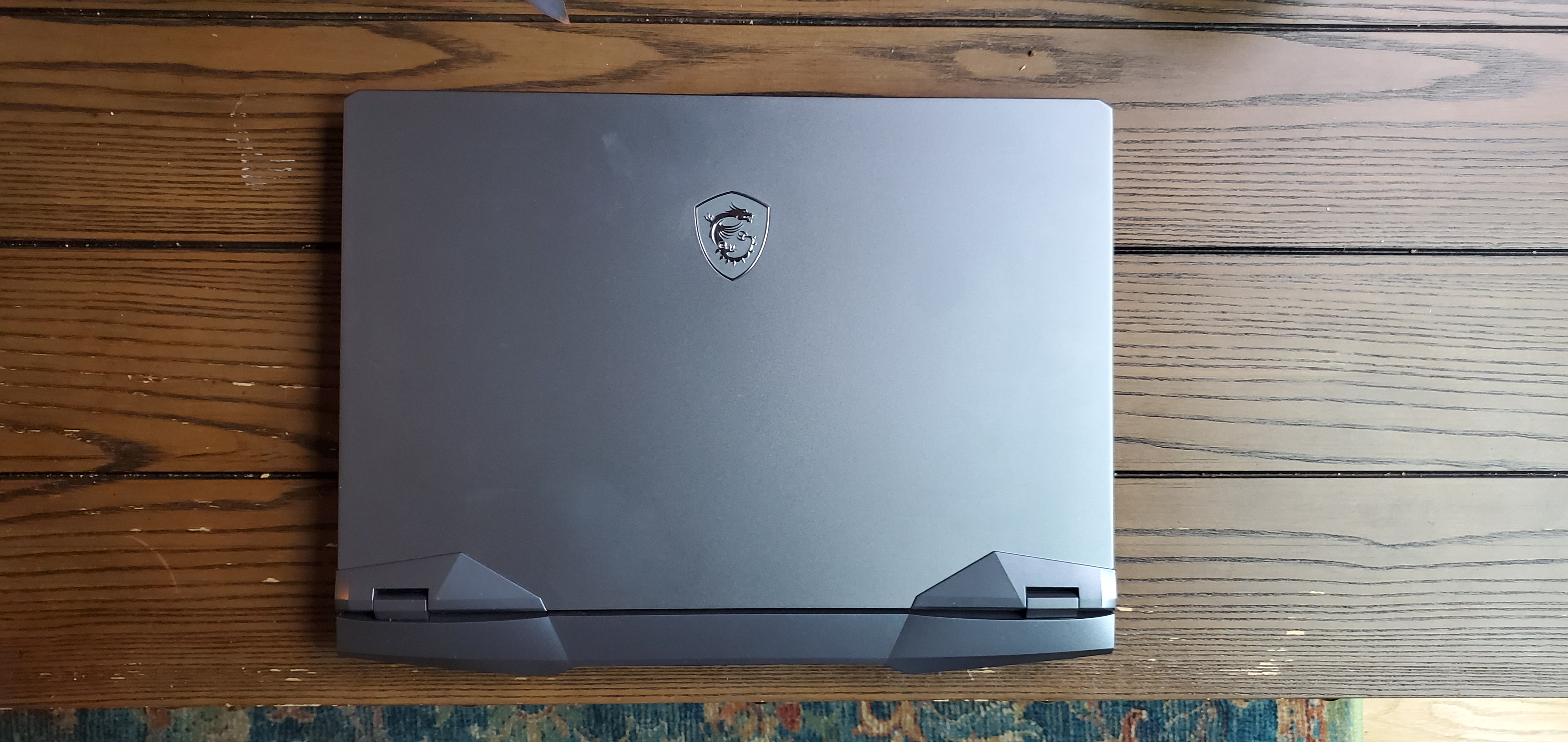
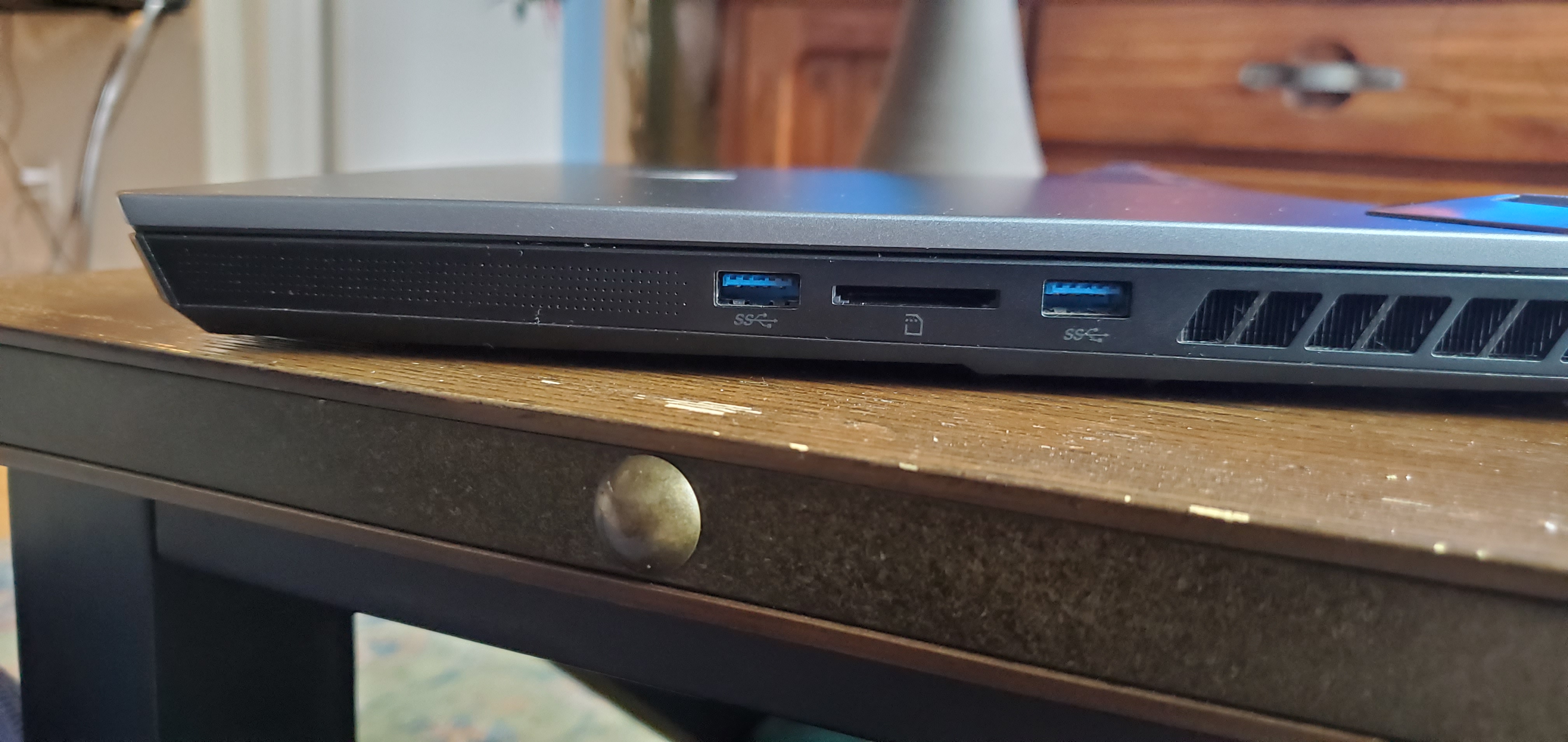

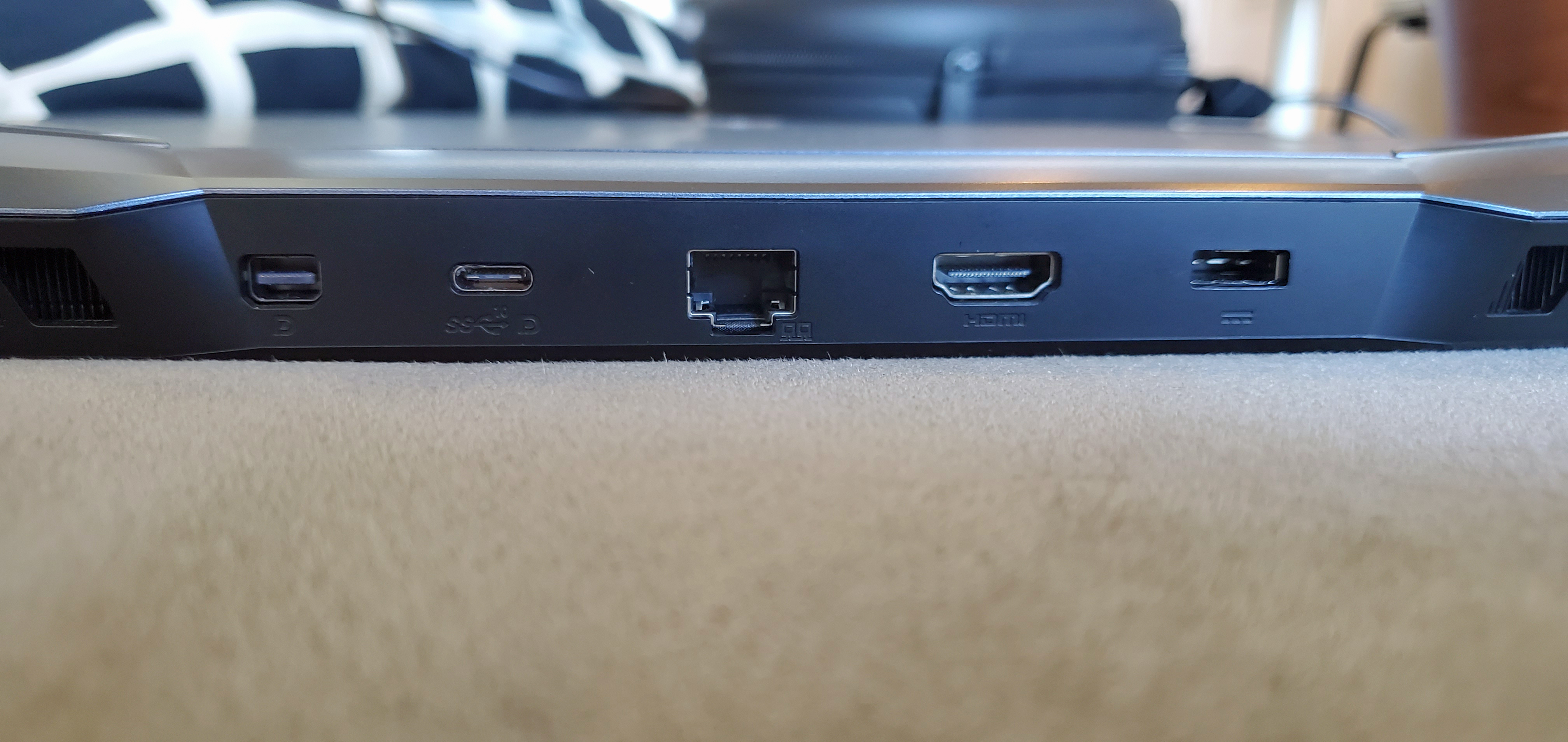

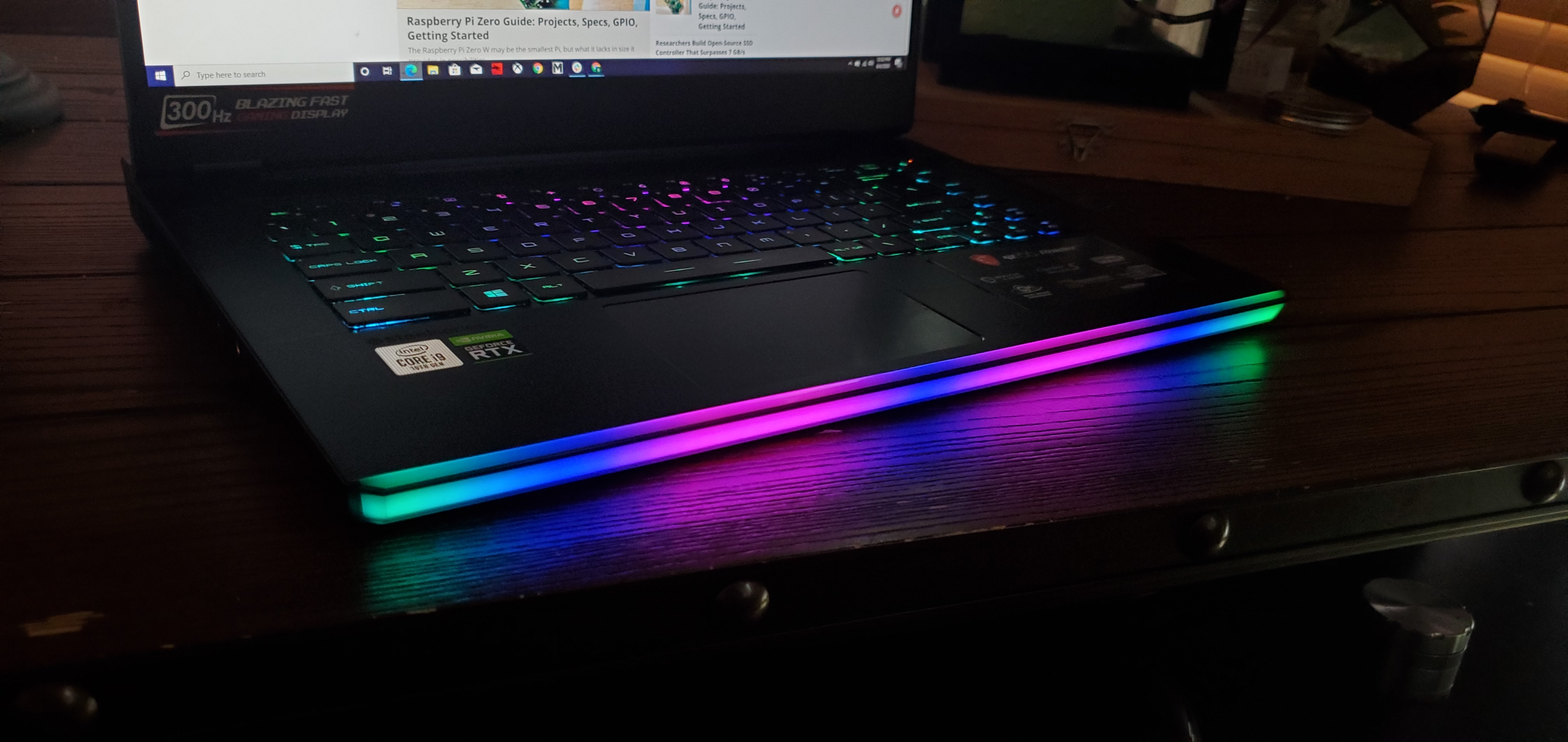

How does a laptop manage to look more mature and more wild than your typical gaming clamshell? A cool and classy chassis underscored (quite literally) by a stunning RGB bar, that’s how. The GE66 Raider isn’t the only laptop to incorporate colorful LEDs on its deck. The Asus ROG Strix Scar 17 G732 has a light bar on three sides. However, I’d argue that the GE66 Raider does it best. The boldness of the light bar and its beveled glass encasement make for a crystalline vibe that goes galactic with the right color scheme. The default settings (a combination of fuchsia, blue and green) is enough of a show to cross the Aurora Borealis off my bucket list. (Okay, not quite). But with those same default settings on the keyboard, it’s one prismatic phenomenon that’s probably as showy as RGB can be without inducing nausea.
Speaking of the keyboard, this one is from SteelSeries and offers per-key programming via SteelSeries’ Engine 3 software, as is the RGB light bar. But only the default setting was cosmic enough for me to warrant this level of RGB spectacle.
The aluminum lid is a royal shade of gray, fitting for the dragon shield that tops it. The logo’s raised silver outlining is the sort of attention to detail that makes company logos more forgivable. Plus, a dragon emblem is way cooler than someone's last name in a circle (for example). Sadly, silver only lives on the lid; the rest of the laptop is black, which, perhaps, helps the RGB pop.
On the left side of the GE66 Raider’s black deck is a USB 3.2 Gen 2x2 Type-C port (20 Gbps), a USB 3.2 Gen 2 Type-A (10 Gbps) port, plus a 3.5mm headphone/mic jack. The right side has a pair of USB 3.2 Gen 1 Type-A ports (5 Gbps) and, surprisingly, an SD card reader. There are more ports on the laptop's spine, namely HDMI 2.0, Mini DisplayPort 1.4, and RJ45 Ethernet port and a port for MSI’s proprietary charger. MSI really has all the bases covered here.
The underside of the laptop has what MSI calls “Dragon armor carving,” which is really a bunch of stretched out hexagons. Overall, this feels like a solid machine with only a small amount of flex in its thin, 15.6-inch screen. MSI says it increased the torque on the hinge by 14% over the last generation (the MSI GE65 Raider) and widened it 9%.
Get Tom's Hardware's best news and in-depth reviews, straight to your inbox.
The sleek black deck is smooth with a very subtle hint of shimmer. Combined with the 5mm thin bezel around the display, 82% screen-to-body ratio and, again, the mesmerizing effect of the RGB keyboard and light bar, you’ve got a machine that seems premium where needed and fun where wanted.
The GE66 Raider stacks up averagely when it comes to 15-inch gaming clamshells. The Asus ROG Zephyrus Duo 15 GX550, for example, is 14.1 x 10.6 x 0.8 inches and 5.3 pounds, while our MSI review unit is 14.1 x 10.5 x 0.9 inches and the same weight. You can get sleeker though. The MSI GS66 Stealth, as its name subtly suggests, is slightly lighter at 4.6 pounds and trimmer at 14.2 x 9.7 x 0.7 inches.
MSI GE66 Raider Gaming Performance
With an RTX 2080 Super Max-Q graphics card, our review unit of the GE66 Raider easily hit 60 frames per second (fps) in most games. I enjoyed Battlefield V at ultra settings typically in the 80-90 frames per second (fps) range. During intense battles, it’d drop to roughly 73-76 fps, and when I crawled through some grass it climbed as high as 130 fps. After I added ray tracing into the mix, framerates stayed around the 70-80 fps range, hitting 99 fps during calm moments and the low 70s in heavy battle.
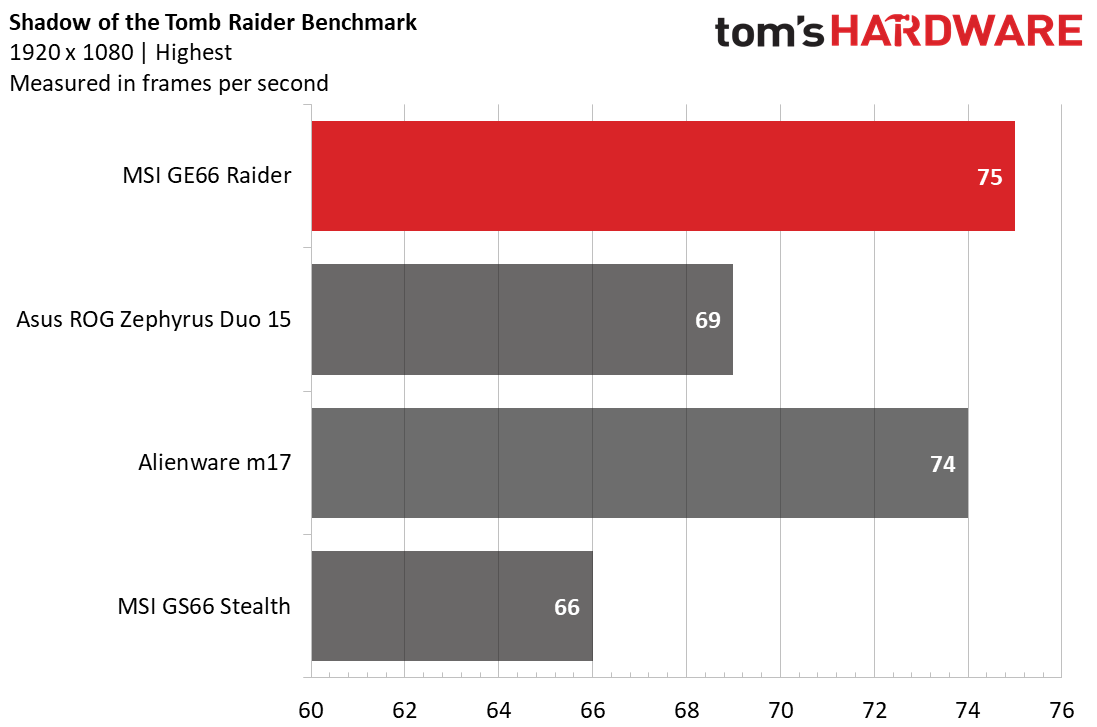
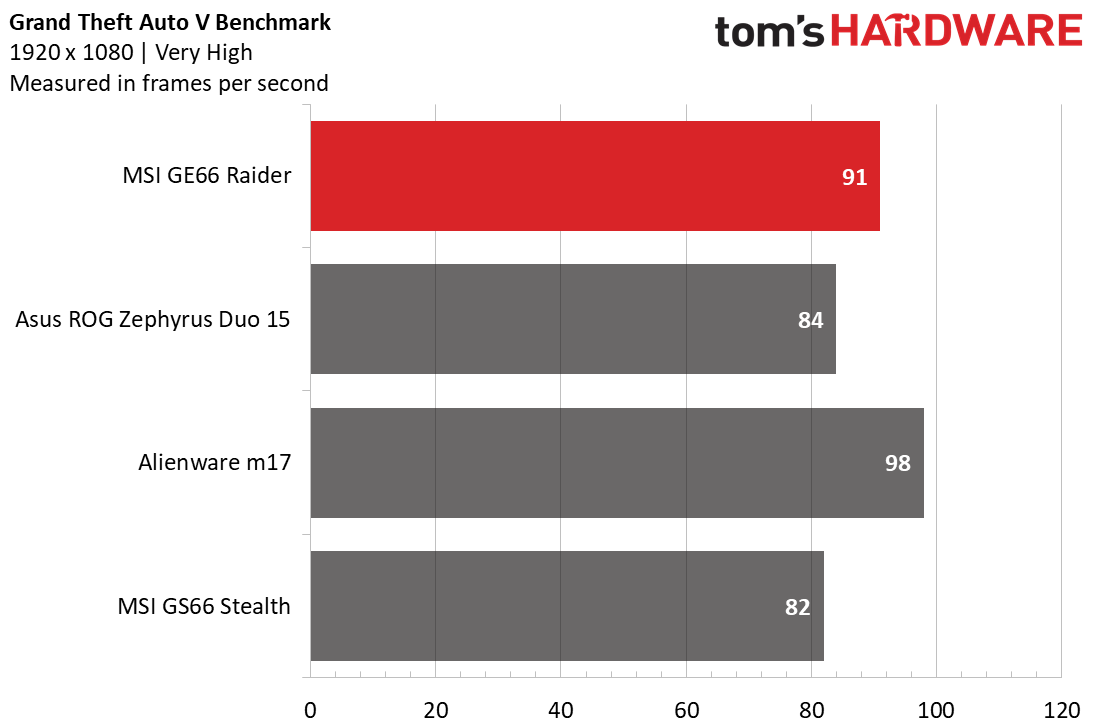
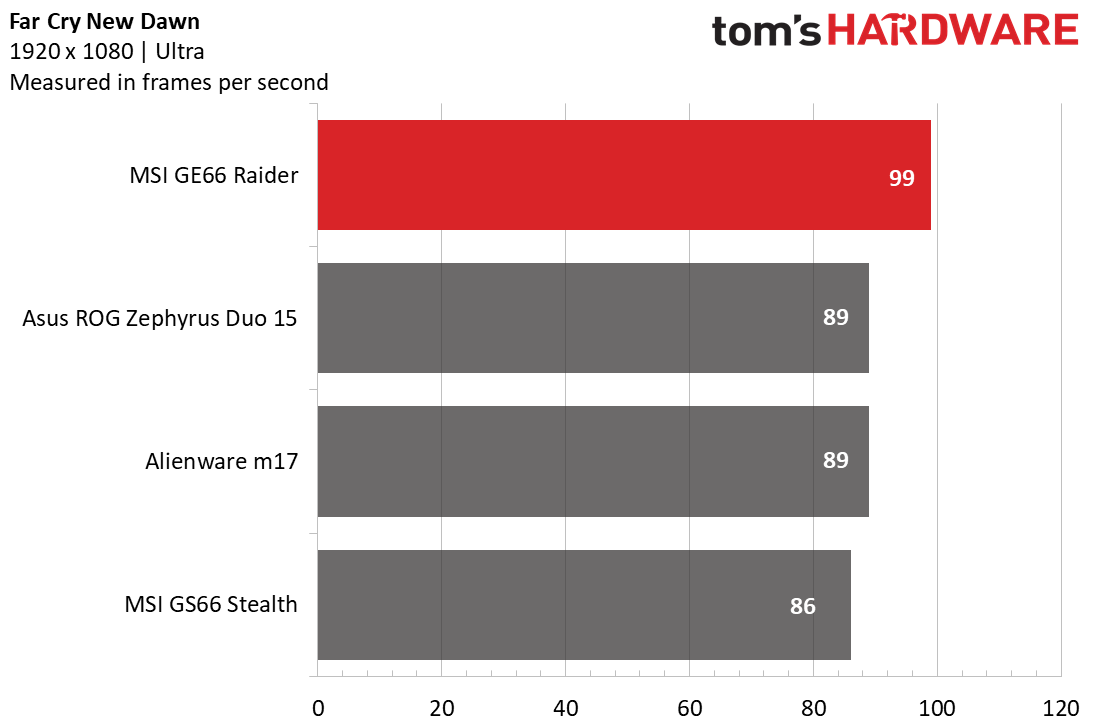
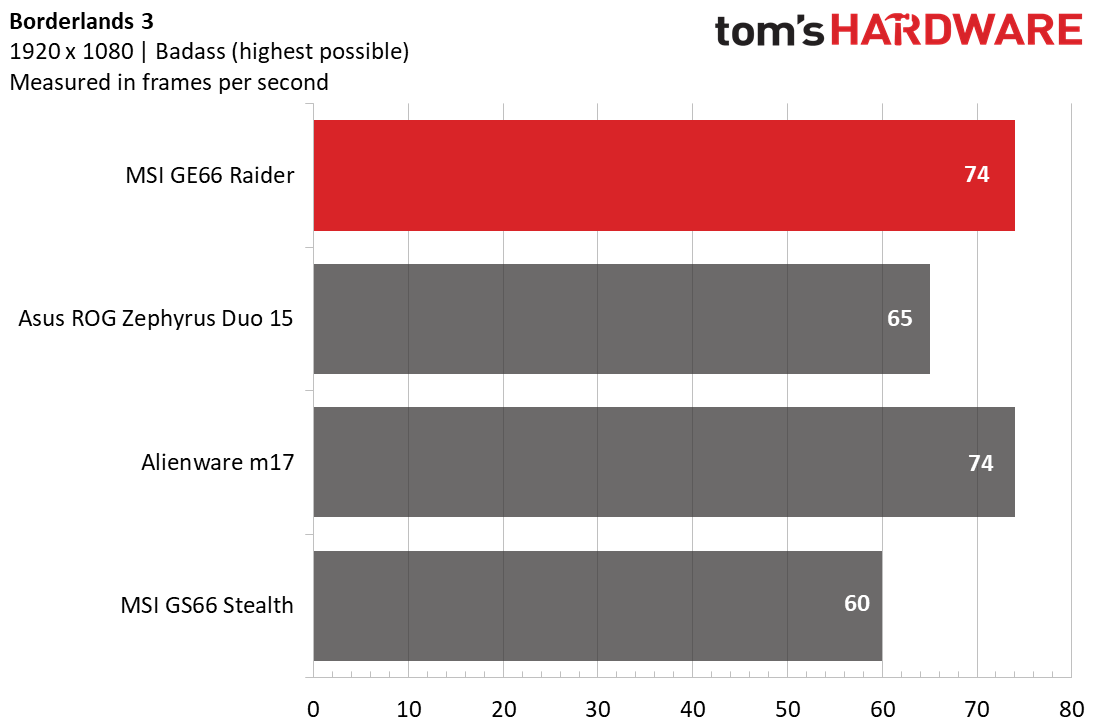
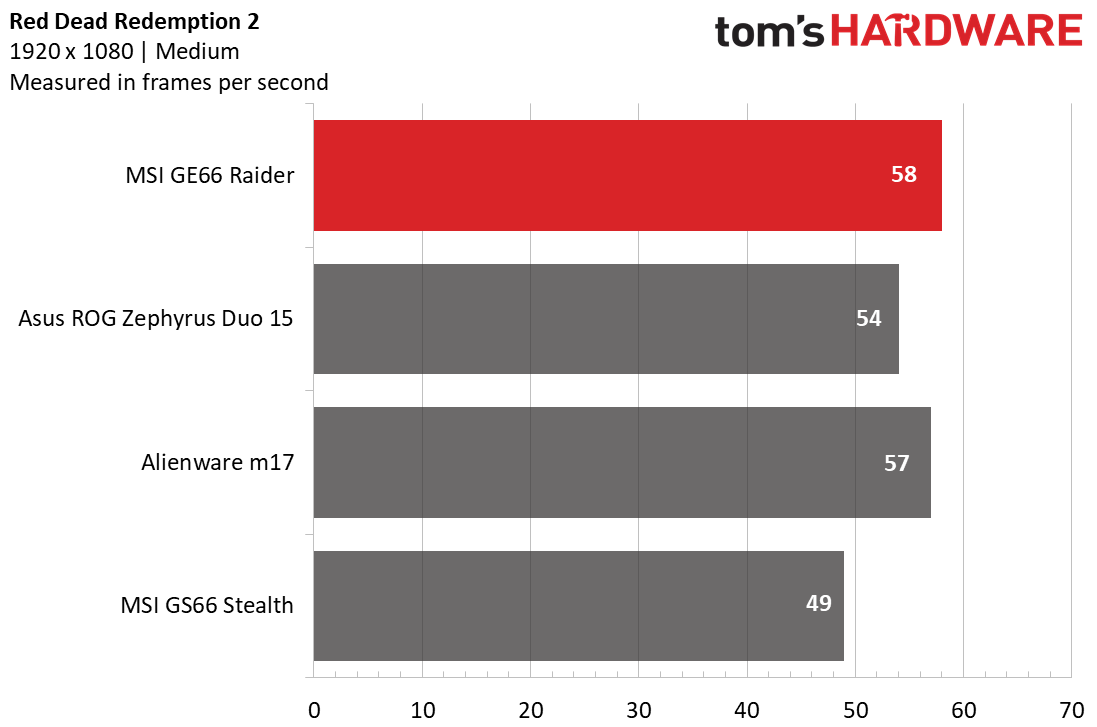
When it came to running the Shadow of the Tomb Raider benchmark (1920 x 1080, highest settings), the GE66 Raider averaged 75 fps. That’s 6 more fps than the Asus ROG Zephyrus Duo 15 GX550 and greater than the MSI GS66 Stealth’s 66 fps average. Both laptops use the same GPU as our review unit. Meanwhile, the Alienware m17 R3 with a Nvidia Geforce RTX 2080 Super came close to matching the GE66 Raider at 74 fps.
Our review unit outperformed its sibling MSI machine and the ROG Zephyrus Duo when it came to Grand the Grand Theft Auto V benchmark (1920 x 1080, very high) as well. However, the Alienware bested the MSI by 7 fps.
The Far Cry New Dawn (1920 x 1080, ultra) benchmark ran at 99 fps on our GE66 Raider. That’s 10 more fps than the Asus and Alienware and 14 more fps than the GS66 Stealth averaged.
The GE66 Raider also comes out on top when looking at Red Dead Redemption 2 (1920 x 1080, medium). Our configuration ran the benchmark at 58 fps, which is slightly faster than both the Zephyrus Duo and m17 R3 and 9 fps quicker than the other MSI machine here.
To stress test our review unit, we ran the Metro Exodus 1080p RTX benchmark on a loop 15 times to simulate 30 minutes of gaming. During this time, the game ran at an average framerate of 51.9 fps. The RTX 2080 Super Max-Q ran at an average clock speed of 1,360.4 MHz and temperature of 64 degrees Celsius (147.2 degrees Fahrenheit). The CPU, meanwhile, was running at 4.4 GHz average clock speed and 76.5 degrees Celsius Average (169.7 degrees Fahrenheit).
MSI GE66 Raider Productivity Performance
The configuration of the GE66 we tested has an Intel Core i9-10980HK with eight CPU cores and 16 threads, working with 32GB (2x 16GB) of DDR4-3200 RAM and a 1TB PCIe NVMe SSD. That’s a lot of power, and the laptop proved more than sufficient for running 22 Google Chrome tabs, including one playing Netflix, as well as Slack. I was able to track through an episode on Netflix with a 1-3 second delay. And there were no obvious delays when navigating or scrolling through my numerous browser tabs.
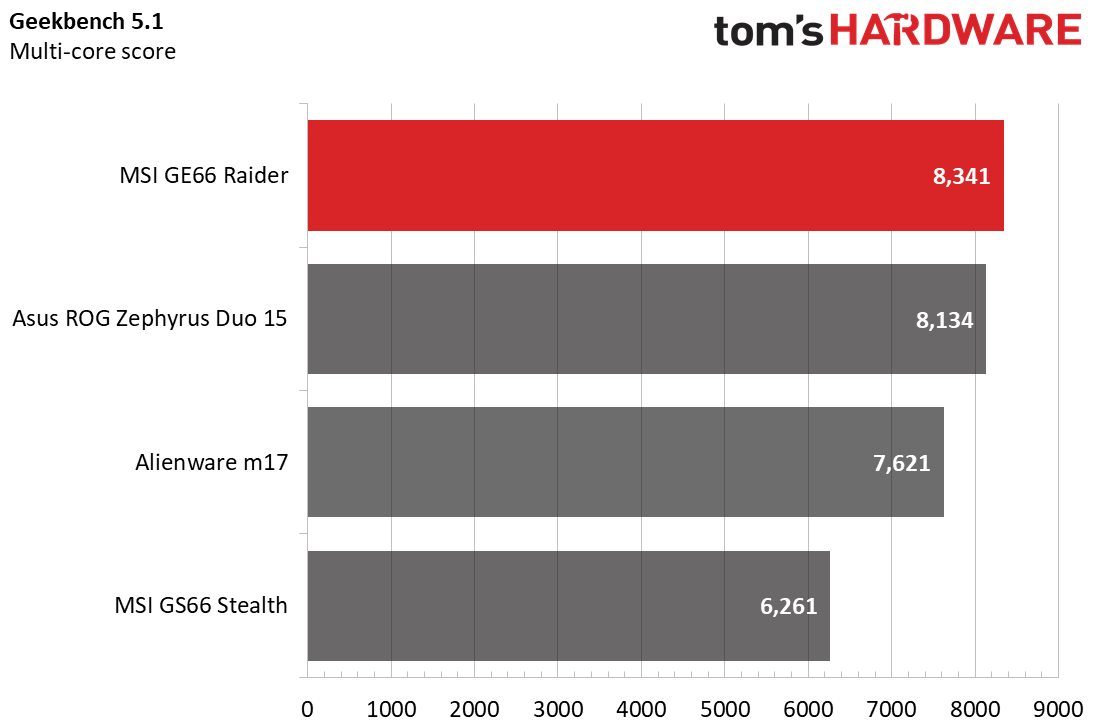
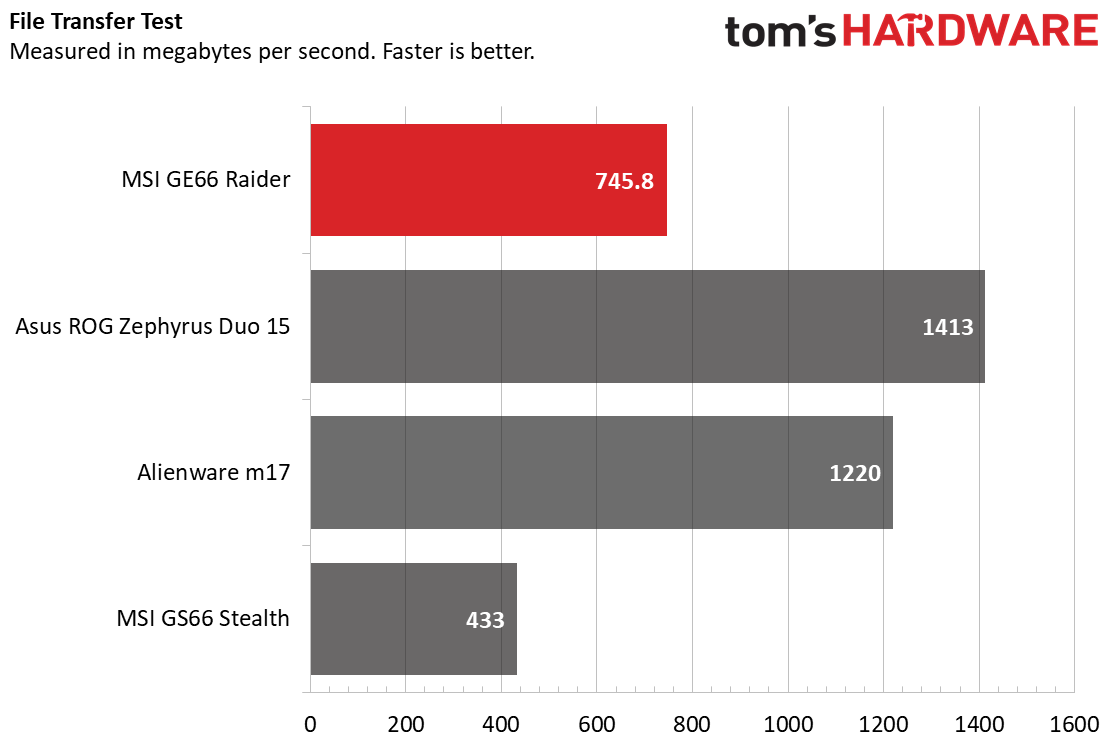
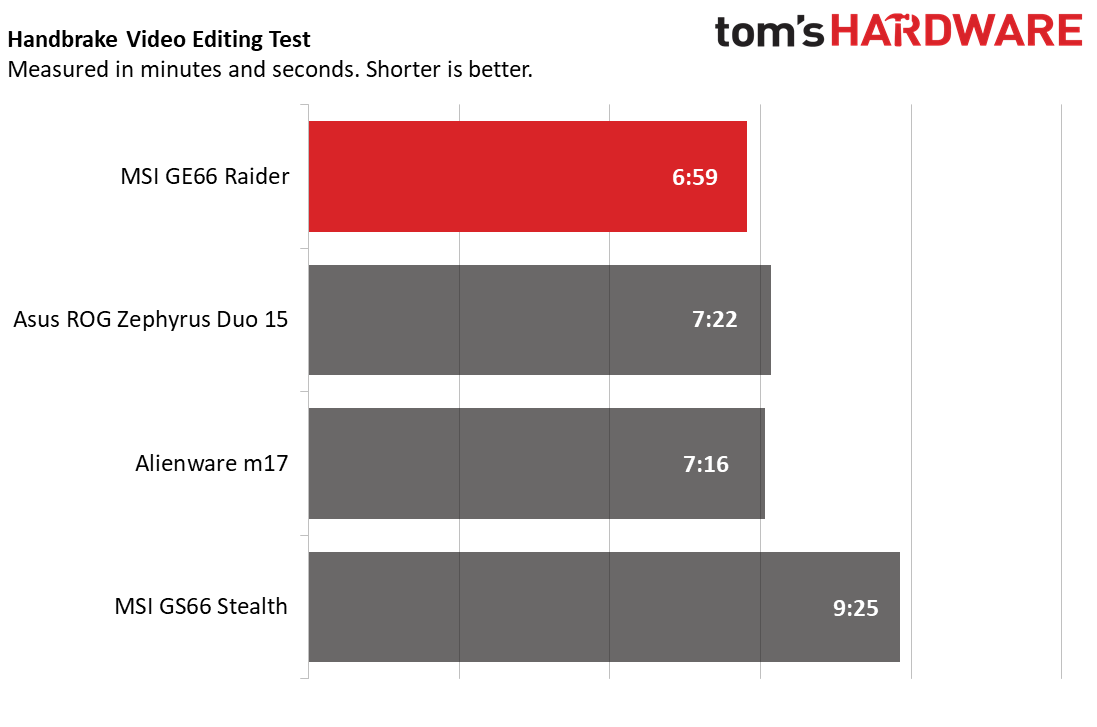
On Geekbench 5.1, an overall productivity performance benchmark, our configuration of the GE66 Raider proved more effective than the other machines here. Its score of 8,347 on all cores outshined the ROG Zephyrus Duo. The Asus scored 8,134 with the same specs as our review unit but with two 1TB SSDs in RAID0. The Alienware also has the same CPU and RAM as our GE66 Raider and a 1TB drive in RAID0. It fell behind our review unit by 720 points. The GE66 Stealth got 6,261, with a lesser Intel Core i7-10750H CPU, 32GB of DDR-2666 RAM and a 512GB SSD.
It took our review laptop 36 seconds to copy 25GB of files, which equates to 745.8 MBps. That’s much slower than the ROG Zephyrus Duo’s 1,413 MBps and the Alienware’s 1,220.4 MBps. The GE66 Stealth, however, was at a comparative crawl.
The GE66 Raider shined in Handbrake. It took the laptop 6 minutes and 59 seconds to transcode a video from 4K resolution to 1080p. That’s quicker than all the other laptops here, especially the GS66 Stealth, which needed 2:56 longer.
MSI GE66 Raider Display
The screen on the GE66 Raider packs a wildly fast refresh rate of 300 Hz, coupled with a 3ms response time. This is part of a growing trend of gaming laptops sporting insanely high refresh rates, including the 300 Hz Razer Blade Pro 17 (2020) and Asus ROG Strix Scar 17 G732.
Even the best gaming monitors are still stuck at 240 Hz max (360 Hz desktop monitors are en route). But while the screen may update with new information 300 times a second, your graphics card may not be so fast, depending on the game you’re running. AAA titles are out of the question when it comes to hitting 300 fps. Instead, you’ll have to play an esports game, like Tom Clancy's Rainbow Six Siege, FIFA, Rocket League or CS:GO to get past the 240 fps mark.
Overwatch is another contender for high framerates, so I dropped settings to the lowest on the GE66 Raider. I surpassed 240 fps quite frequently. Framerates were as high as 301 during a low-intensity training session, and during actual gameplay it usually was in the 250-260s, sometimes dropping as low as 194 fps and reaching as high as 281 fps.
In terms of image quality, the GE66 Raider’s screen packs a healthy amount of color for both gaming and movies. Overwatch looked as pleasant as ever on the laptop, with tanks featuring their gold tones instead of looking like a pale yellow. I could also see the nuanced shades of gray in Reinhart’s weapon, which can look more washed out and flat on other screens.
Mission: Impossible - Fallout also looked as colorful as I expected after watching it numerous times on a large TV. Green poplars in a garden stood out, as did the subtly olive tone of Ilsa’s jacket. The purple-pinkish haze that subtly covers a scene at an airport at dusk and is often lost on other displays was also visible.
The panel is IPS style, and side angle viewing lives up to expectations. When watching Mission: Impossible from a 90-degree angle there were reflections on the further half of the screen, but it was still watchable, especially for a movie this good. At a 45-degree angle, there were virtually no issues.
Our testing showed that this speedy panel averages a solid 300 nits max brightness. However, every other laptop here has a brighter screen, including the smaller second screen on the Zephyrus Duo. The other MSI and the ROG Zephyrus Duo offer a similar amount of coverage of the DCI-P3 color gamut as the GE66 Raider. However, the Alienware is incredibly colorful.
MSI GE66 Raider Keyboard and Touchpad
I love a trim gaming laptop, but in the GE66 Raider’s case, that comes at the price of a spacious keyboard. MSI said it enlarged the keycaps, especially the left Ctrl key, compared to the GE65 Raider. But there are also some (but not all) navigational keys squeezed into the right column, and the arrow keys that aren’t offset enough to be easily locatable. At the end of the day, you’re left with keys that are pretty close together and very flat, making it easy for the fingers to slide across to other keys accidentally. There are also some weird choices, like the abomination of the left FN and Ctrl keys crammed into one space.
When gaming, this resulted in mispressed keys and me having to look down more often than usual to reorient myself. The larger Ctrl key helped, but I still found it hard to find other keys when holding down Ctrl, like when I was trying to slide in Apex Legends. And when trying to input combos, I had to look down to figure out where I was in a sea of flat keys.
On the 10fastfigners.com typing I test I averaged 113.7 words per minute with a 96.6% accuracy rate. That’s pretty typical for me and only slightly below my 98% average accuracy, likely due to how snappy the keys are. But my fingers felt a little worn out afterward.
On the other hand, the keyboard’s quite functional. As mentioned, you get some navigational keys, like Home and Page Up. You can also use the function row to toggle the webcam off (handy for privacy), activate crosshairs for training, enter Game Mode, quickly turn the fans to max speed and toggle through the keyboard and light bar’s premade RGB effects simultaneously or control RGB brightness.
The GE66 Raider is also rocking a 4.1 x 2.5-inch touchpad, which I found to be a good size. It isn’t very slippery, instead offering a healthy amount of friction for control. I had no problem navigating Windows 10 with touchpad gestures.
MSI GE66 Raider Audio
The MSI GE66 Raider’s two 2W speakers live on either side of the deck, a more logical location than speakers that are under the laptop, which can result in muffled sound. They’re Dynaudio brand (if you forget, a logo on the deck will remind you), and MSI says they support up to a 192 KHz sampling rate and 24-bit Hi-res audio and go up to 122 dB.
In Overwatch, the overall sound was a little tinny. But I’ve heard worse, especially on other gaming laptops and thin ultraportables. The battlegrounds sounded like there were people banging on different types of metal trash cans as opposed to firing off different weapons. The audio didn’t sound as layered as usual, and even Reinherart’s voice was more metallic. When I switched to external speakers, I could hear more bass and a greater variance in weapon noises. The speakers’ volume, on the other hand, was ample, even with all my windows and balcony door open on a rainy day.
Music also sounded different than usual. When I played “Like Glue,” Sean Paul sounded like he was singing far away down a tunnel and higher pitched. Moving to speakers resulted in a warmer voice with more bass. The instruments in The Strokes’ “What Ever Happened?” didn’t sound as detailed on the GE66 Raider either.
MSI GE66 Raider Upgradeability
Once you remove 11 Philips head screws and apply some elbow grease, you can pry off the GE66 Raider’s cover for upgrading. You can replace the RAM to reach up to 64GB (mine had two 16GB sticks), and my unit also had an empty spot for adding another M.2 SSD by removing an additional Philips head screw. You can also unscrew the Wi-Fi card.
MSI GE66 Raider Battery Life
Like the GS66 Stealth, MSI gave the GE66 Raider a 99WHr battery, the largest size it’s legally allowed to implement into a laptop, a company rep told me. But while the GE66 Raider may offer a lot of performance in a more portable package, you’ll still want to bring the charger if you plan on using it all day.
The GE66 Raider lasted 4 hours and 57 minutes on our battery test, which surfs the web, streams video and runs browser-based OpenGL tests while connected to Wi-Fi and with the screen at 150 nits brightness. This isn’t bad for a gaming laptop, but the GS66 Stealth lasted 1:39 longer. You can also get over an 1:15 more playing time with the ROG Zephyrus Duo if you’re willing to turn its second screen off. Still, the GE66 Raider’s battery life seems like a lifetime compared to how long the Alienware m17 R3 lasted.
MSI GE66 Raider Heat
As with many gaming laptops, the GE66 Raider can get pretty warm. It was common for me to notice the keyboard heating up, even during light productivity tasks and with fans set to max performance. Despite its thin stature, the GE66 Raider’s fans can get as loud as your typical gaming laptop when blazing at max speed.
In my experience, the GE66 Raider got too hot to use on my lap for long periods, and the keyboard was usually noticeably warm with the space above it being shockingly hot at times, even when just surfing the web.
After 15 minutes of playing YouTube videos, the Raider’s touchpad was 84.5 degrees Fahrenheit (29.2 degrees Celsius), and the spot between the G and H keys was 107.5 degrees Fahrenheit (41.9 degrees Celsius). But that hottest point was on the underside in the center, where the temperature hit 125 degrees Fahrenheit (51.7 degrees Celsius).
MSI rejigged the cooling system compared to the GE66 Raider’s predecessor that helped keep it 0.9 inches thick compared to the GE65 raider’s 1.1 inches. The company’s Cooler Boost 5 cooling system here uses two fans with 53 blades, besting the latter’s 37 blades. Each blade is 0.25mm thick, which is 38% thinner than before and supposed to help drive more airflow. The six copper heatpipes are also supposed to be wider than that of the GE65 Raider.
MSI GE66 Raider Webcam
The webcam on the GE66 Raider is, thankfully, 1080p (at 30 frames per second), rather than the 720p that’s not uncommon in today’s laptop webcams. With video calls becoming a bigger part of the work day, the sharper resolution is more important than ever. And given Asus ditched the webcam altogether on many of its recent gaming laptops, we’re happy to see MSI step things up this way.
The webcam here proved decent. It was slightly, but not very noticeably, sharper than a 720p laptop webcam in a side-by-side comparison, with less fuzz and graininess. But my skin was still slightly grainy, and the color was slightly too cool.
MSI GE66 Raider Software and Warranty
Our MSI GE66 Raider came with several MSI-branded apps.
MSI Dragon Center primarily provides an overview of your PC’s components, namely CPU, GPU, disk, memory and SSD. You can get info like fan speeds, temperatures and amount of space remaining. This is also where you can toggle between Extreme Performance, Silent, Battery and more to control fan intensity. And if you have components or peripherals that support MSI’s Mystic Light RGB, you can sync effects.
MSI True Color offers different picture modes, like gamer, anti-blue and sRGB, with some offering sliders for further adjustments. It also includes a small number of tools, the most helpful of which is the crosshair. And MSI App Player would be handy if I had an Android phone and wanted to sync games between the two PCs.
You also get Killer Control Center, which is useful for focusing bandwidth on a particular app, such as when downloading a new game or streaming. MSI also threw in Nahimic Sound Sharing, which lets you tweak audio on connected speakers or headphones and play with the built-in mic.
Of course, you also get your typical Windows 10 bloatware, like Xbox Game Bar.
MSI backs the GE66 Raider with a 1-year warranty.
MSI GE66 Raider Configurations and Availability
At $2,999, our configuration of the GE66 Raider is as powerful as it gets. It comes with an Intel Core i9-10980HK CPU, Nvidia GeForce RTX 2080 Super Max-Q (8GB GDDR6) graphics, 32GB of DDR4-3200 RAM and a 1TB NVMe PCIe SSD. You can find it by the SKU number GE66 Raider 10SGS-057.
The cheapest version, the GE66 Raider 10SF-285, is $1,899. For that price, you get an i7-10875H, RTX 2070 graphics, 16GB of RAM and 512GB of SSD storage. The display also drops to a ‘mere’ 240 Hz, which is, of course, still plenty for most serious gamers. Alternatively, you can pay the same price for a 144 Hz screen; the benefits there are a bump to a 1TB SSD, but you also get a i7-10750H CPU instead, which is a hexa-core processor compared to the i7-10875H’s octa-core chip.
There are three available SKUs in between. The GE66 Raider 10SGS-288 for $2,799 (i7-10875H / RTX 2080 Super Max-Q / 32GB / 1TB) is the only configuration besides our review unit that also offers a 300 Hz screen.
Bottom Line
The MSI GE66 Raider is a powerhouse of a gaming laptop with looks to match. With its high-end but slim shell, powerful GPU, 10th Gen Intel Core i9 CPU and a lot of storage, you won’t be left wanting or bogged down with bulk.
Our pricey configuration usually topped our comparison group more when it came togaming performance. And its 300 Hz screen won’t go to waste if you’re an esports player. We surpassed 240 fps regularly on Overwatch and even climbed past 300 fps during more idle gameplay time. Productivity performance was also comparable to rivals, and I had no issues multi-tasking.
However, if you want a very colorful or bright screen, the Alienware m17 is a much better choice. The Asus ROG Zephyrus Duo 15 is also better in that regard, plus may be as lavish as the GE66 Raider, thanks to its second screen.
But if you can afford to make this investment in performance and prettiness, the GE66 Raider is pure premium gaming luxury.

Scharon Harding has over a decade of experience reporting on technology with a special affinity for gaming peripherals (especially monitors), laptops, and virtual reality. Previously, she covered business technology, including hardware, software, cyber security, cloud, and other IT happenings, at Channelnomics, with bylines at CRN UK.
-
Phaaze88 Aww, H-E-double hockeysticks no!Reply
https://cdn.mos.cms.futurecdn.net/BuYPw3f2XuJ6cQowJwAgbX.jpghttps://cdn.mos.cms.futurecdn.net/eRZkaXLuxmNnUchRR4ac6U.jpg
Shared heatsink on a 3000USD laptop, crappy Max-Q gpu, and incompetent bottom ventilation design - manufacturers need to stop with trying to give flair to things that don't need flair! Open up the rest of those vents, and give people their cooling, for crying out loud!
Who looks at the bottom of their laptops to admire whatever crap design is down there? Vent up half the bottom and be done with it.
What is this overpriced garbage?
